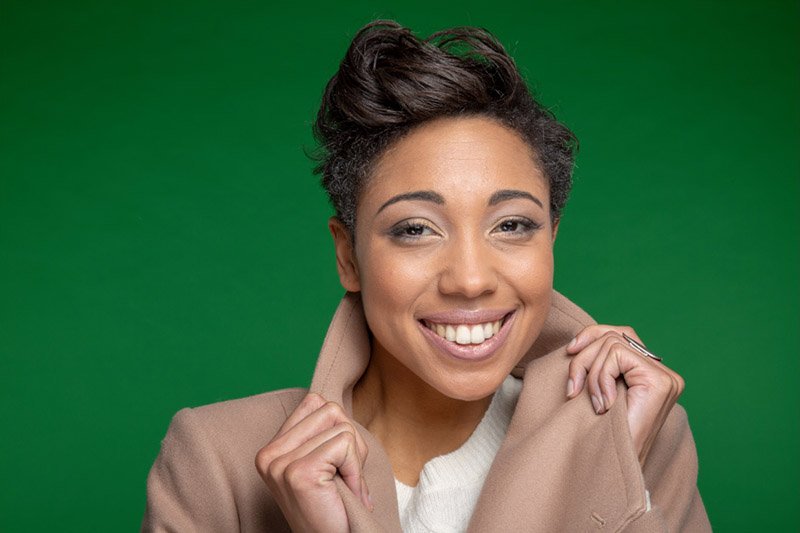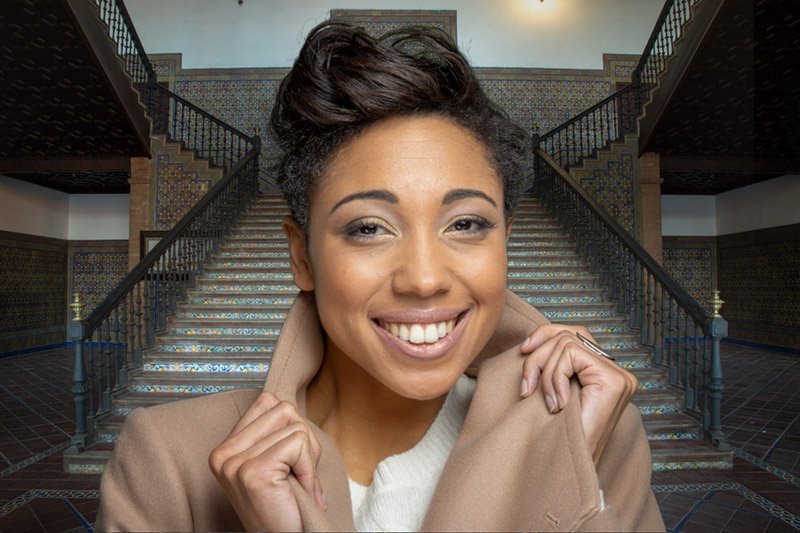Green screens and blue screens have been used for decades for filmmaking and photography and have become an invaluable part of a photographer’s toolkit. By photographing subjects against a green screen or a blue screen, the subjects can be easily isolated and placed onto a new background.
Here is an example of a model photographed against a green screen:

Imerge Pro provides a range of effects that remove the green screen background and any extraneous elements from the photo, leaving a cleanly isolated version of the woman:

Imerge Pro can then be used to add in a new background and make other adjustments to positioning and appearance:

Automatically removing the green screen or blue screen from the original image is known as ‘keying’, a process designed to eliminate or reduce the amount of manual work required. Imerge Pro is designed for both individual portrait work and mass processing at major live events.
Green screen or blue screen?
The most important aspect of keying is to ensure that the background screen can be easily separated from the foreground subject. You want your screen to be as different to your subject in color as possible.
This is why red screens are not commonly used – due to the amount of red in human skin, it’s impossible to get good results with a red screen. Yellow screens would have a similar problem. Green and blue are both far less prominent in skin tones and therefore work as successful keying colors. Take careful note of clothing, hair and other objects in the shot and make sure that you choose an appropriate backdrop.
If you absolutely can’t avoid some color clashes, take a look at the Masks chapter.
Some digital cameras also have a tendency to retain more green data than blue, so if you are in a position to freely use either green or blue it is generally advisable to choose green. Blue screen was the best option for the optical keying processed used for handling film, but the different methods used for digital processing favor green. Either color is still capable of excellent results.
Types of blue or green screens
Blue screens and green screens can be purchased or rented, or you can build your own using appropriate materials. Each has it own advantages and disadvantages.
- Fabric: Soft fabric screens are very portable, and so can be set up anywhere. They are durable, and can be washed or pressed when necessary. On the other hand, they can easily get wrinkled or stained. Pop-up screens, similar to pop-up reflectors, are another option for portability.
- Paper: A pull-down paper screen which can be rolled up when not in use is ideal for a studio. They are very affordable, but delicate, and can easily be wrinkled or torn. Their delicate nature makes them a poor choice for location work.
- Paint: If you have a permanent studio space for green screen work you can also consider chroma green paint. Green paint is excellent for durability, as there are no concerns about wrinkles, but it is not at all portable, and requires a dedicated space.
Setting up your green screen
Green screen and blue screen photography has a few unique factors you will want to bear in mind while planning your shoot. Taking a little more time during setup to ensure everything is set up properly can save you a huge amount of time when you get on the computer, and ensure the best possible results.
- Non-reflective background: Make sure your background material is matte, not shiny. Shiny backgrounds will reflect too much light and have bright ‘hotspots’.
- Avoid backdrop textures: Smooth materials that won’t cast any shadows. Creases, wrinkles, or even an excessively heavy fabric weave can create shadows which make it difficult to separate the subject from the background.
- Clean separation: Clear separation between your subject and the background is the key to high quality results.
- Distance from backdrop: Always try to position your subject as far away from the backdrop as possible. This will reduce the amount of green or blue that is reflected onto them and avoid casting shadows onto the screen. Aim for a minimum of 6 feet when possible, but a greater distance will reduce color spill even more.
- Avoid shadows: Make sure your subject is not casting any unwanted shadows on the backdrop. Shadows will make compositing much more difficult. If you need a shadow in your composite, it is often easier to create it in post, rather than trying to retain a shadow throughout the keying process.
- Lighting: Light your backdrop independently from your subject. This enables you to light your background smoothly while retaining a more dramatic setup for your subject. Trying to light your background and subject with the same lights will make it difficult to avoid shadows, to maintain even lighting, and to get clear separation of your subject.
- Reducing spill: If you are getting a lot of bounced green spill light on your subject try moving your subject farther from the backdrop. If this is not possible, you can try adding a very subtle magenta backlight to your subject. Magenta light on the back of your subject can help to counter green spill reflecting from the greenscreen, and increase separation.
Need more help with this?
Don’t hesitate to contact us here.
